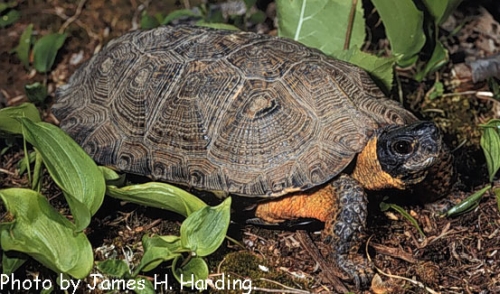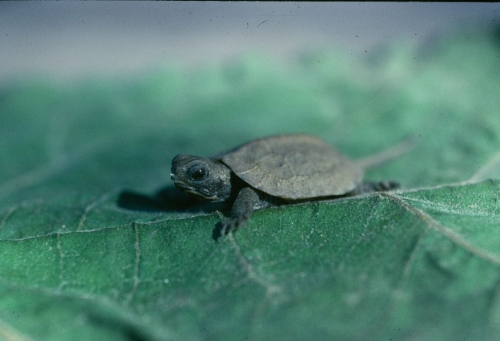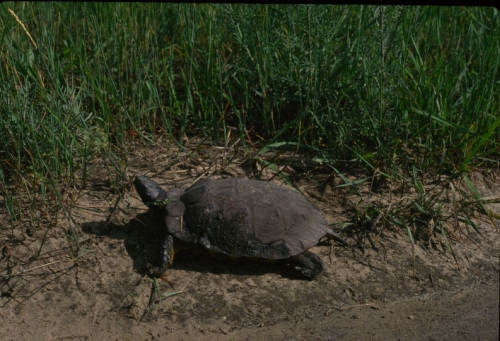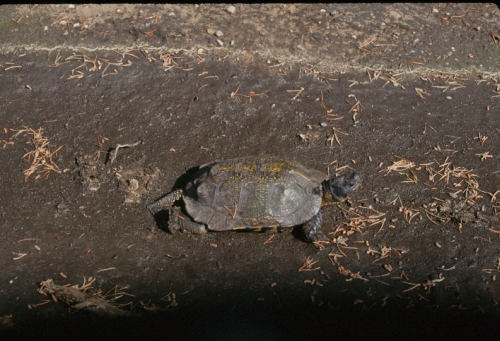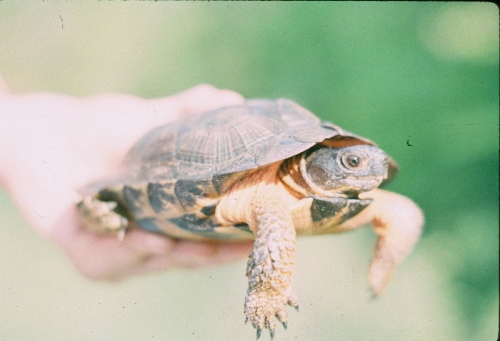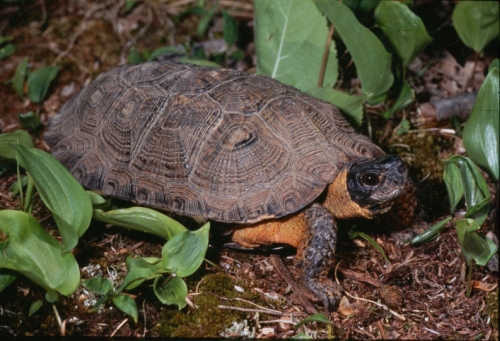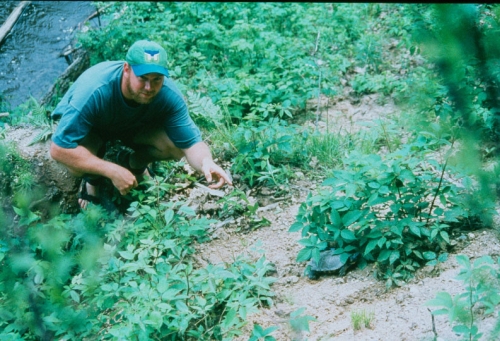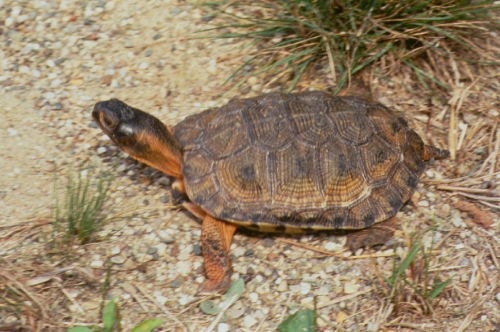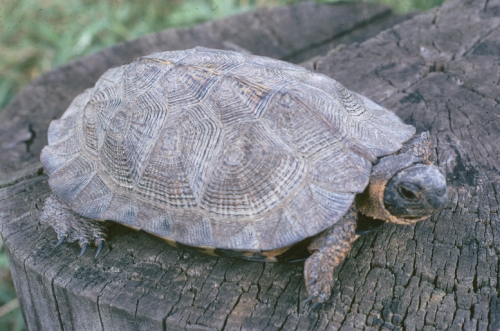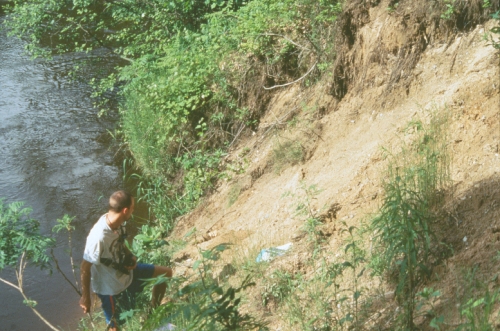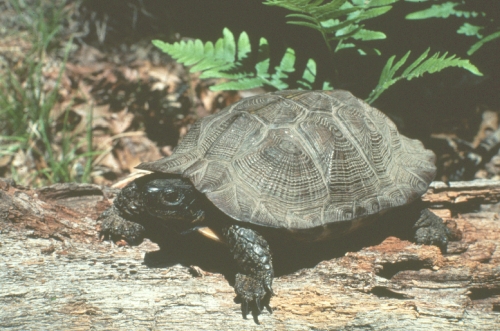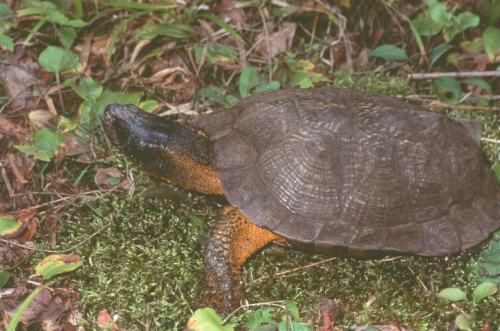Plants and Animals
Glyptemys insculpta Wood turtle
Key Characteristics
The Wood Turtle is a medium-sized turtle, with adult carapace (top part of shell) ranging in length from 6 to 10 inches (15-25 cm). The broad, low carapace usually has a central keel (i.e., a raised ridge running down the center of the shell), and raised, often pyramidal ridges of well-defined concentric growth rings on each scute or scale. The carapace is brown or grayish brown, often with radiating yellow and black lines on the ridges. The plastron (underside of shell) lacks a hinge, and is yellow with dark, oblong blotches along the outer edge. The highly “sculptured” carapace and unhinged, patterned plastron distinguish this species from other turtles in the state.
Status and Rank
US Status: No Status/Not Listed
State Status: T - Threatened (legally protected)
Global Rank: G2G3 - Rank is uncertain, ranging from imperiled to vulnerable
State Rank: S2 - Imperiled
Occurrences
| County | Number of Occurrences | Year Last Observed |
|---|---|---|
| Alcona | 5 | 2008 |
| Allegan | 1 | 1975 |
| Alpena | 2 | 2020 |
| Arenac | 2 | 1998 |
| Baraga | 10 | 2022 |
| Benzie | 6 | 2021 |
| Calhoun | 1 | 2020 |
| Cheboygan | 13 | 2023 |
| Chippewa | 1 | 1997 |
| Clare | 6 | 2020 |
| Crawford | 6 | 2022 |
| Delta | 5 | 2021 |
| Dickinson | 7 | 2021 |
| Gladwin | 6 | 2020 |
| Gogebic | 12 | 2019 |
| Grand Traverse | 5 | 2019 |
| Houghton | 10 | 2018 |
| Ingham | 1 | 1983 |
| Iosco | 14 | 2020 |
| Iron | 3 | 2008 |
| Isabella | 10 | 2022 |
| Kalkaska | 5 | 2005 |
| Kent | 1 | 1996 |
| Lake | 13 | 2022 |
| Macomb | 1 | 2021 |
| Manistee | 22 | 2023 |
| Marquette | 7 | 2022 |
| Mason | 15 | 2020 |
| Mecosta | 3 | 2022 |
| Menominee | 8 | 2022 |
| Midland | 11 | 2022 |
| Missaukee | 4 | 2021 |
| Montcalm | 2 | 2020 |
| Montmorency | 9 | 2023 |
| Muskegon | 10 | 2020 |
| Newaygo | 18 | 2021 |
| Oceana | 6 | 2019 |
| Ogemaw | 2 | 2000 |
| Ontonagon | 24 | 2023 |
| Osceola | 8 | 2021 |
| Oscoda | 6 | 2021 |
| Otsego | 1 | 2021 |
| Presque Isle | 4 | 2020 |
| Roscommon | 2 | 2015 |
| Saginaw | 1 | 1978 |
| Schoolcraft | 9 | 2019 |
| Wexford | 12 | 2022 |
Information is summarized from MNFI's database of rare species and community occurrences. Data may not reflect true distribution since much of the state has not been thoroughly surveyed.
Habitat
Wood Turtles are found primarily in or near moving water and associated riparian habitats. They prefer clear, medium-sized (range 7-100 ft / 2.1-30.5 m), hard-bottomed streams and rivers with sand and/or gravel substrates and moderate flow. Wood Turtles also require partially shaded, wet-mesic herbaceous vegetation such as raspberries, strawberries, grasses, willows, and alders along or near the river for foraging. Forested floodplains (deciduous and coniferous) with numerous sunlit openings and a dense mixture of low herbs and shrubs seem to provide ideal habitat for this species. They also have been found in non-forested habitats such as willow and alder thickets, sphagnum bogs, swamps, wet meadows, and old fields within or near the floodplain. Wood Turtles also require sandy or sandy-gravelly areas along the river for nesting but will utilize gravel pits, railroad crossings, clearcuts, roadways, utility right-of-ways, and residential yards and gardens if natural nesting habitat is not available.
Specific Habitat Needs
Downed woody debris needed in: Headwater stream (1st-2nd order), pool; Headwater stream (1st-2nd order), run; Mainstem stream (3rd-4th order), pool; Mainstem stream (3rd-4th order), run.
Natural Community Types
- Bog
- Hardwood-conifer swamp
- Headwater stream (1st-2nd order), pool
- Headwater stream (1st-2nd order), run
- Mainstem stream (3rd-4th order), pool
- Mainstem stream (3rd-4th order), run
- Mesic northern forest
- Northern shrub thicket
- Northern wet meadow
- Rich conifer swamp
For each species, lists of natural communities were derived from review of the nearly 6,500 element occurrences in the MNFI database, in addition to herbarium label data for some taxa. In most cases, at least one specimen record exists for each listed natural community. For certain taxa, especially poorly collected or extirpated species of prairie and savanna habitats, natural community lists were derived from inferences from collection sites and habitat preferences in immediately adjacent states (particularly Indiana and Illinois). Natural communities are not listed for those species documented only from altered or ruderal habitats in Michigan, especially for taxa that occur in a variety of habitats outside of the state.
Natural communities are not listed in order of frequency of occurrence, but are rather derived from the full set of natural communities, organized by Ecological Group. In many cases, the general habitat descriptions should provide greater clarity and direction to the surveyor. In future versions of the Rare Species Explorer, we hope to incorporate natural community fidelity ranks for each taxon.
Management Recommendations
The most serious threat to this species is poaching for commercial pet trade and incidental collecting by the general public. The public should be informed and educated that this species is protected under the Director’s order and should not be collected or harmed. Maintaining good water quality, controlling sedimentation, restricting pesticide use near waterways, implementing minimum development set-back distances, and leaving buffer zones along streams during timber harvest, grazing, and agricultural operations can help preserve Wood Turtle habitat. Maintaining stream dynamics that create sandy areas along the river is crucial for providing suitable nesting habitat. Maintaining or creating small openings in floodplain forests can provide foraging, basking, and/or nesting habitat. Management practices such as sand traps, streambank stabilization, stream channelization and dams can eliminate or reduce good wood turtle habitat and should be avoided. Predator control may be necessary at nesting areas to enable successful reproduction or recruitment. Road construction near streams and rivers should be avoided or minimized.
Active Period
Active from fourth week of April to second week of October
Breeding from first week of June to fourth week of June
Breeding from first week of September to fourth week of September
Nesting from first week of June to fourth week of June
Survey Methods
Although Wood Turtles can be seen anytime during the active period, the best times to survey for this species are spring and early fall because turtles are active and concentrated near streams. Spring is generally better than fall because herbaceous ground cover is sparser, allowing for better visibility, and turtles are frequently basking in or near water. The leafing out of most deciduous trees in the spring indicates a good time to initiate Wood Turtle surveys. Visual encounter surveys also can be conducted in June in the evenings for nesting females. Visual encounter surveys consist of walking through suitable habitat (e.g., in riparian or floodplain habitat along the stream or river) and searching for turtles basking or foraging in the water or on land.
Visual encounter survey during fall breeding season
Survey Period: From first week of September to fourth week of September
Time of Day: Daytime
Cloud Cover: Clear
Air Temperature: Warm
Wind: Light Breeze
Visual encounter survey during spring breeding season
Survey Period: From fourth week of April to fourth week of June
Time of Day: Daytime
Cloud Cover: Clear
Air Temperature: Warm
Wind: Light Breeze
Visual encounter survey for nesting females
Survey Period: From first week of June to fourth week of June
Time of Day: Evening
Air Temperature: Warm
Wind: Light Breeze
References
Survey References
- Karns, D.R. 1986. Field Herpetology: Methods for the Study of Amphibians and Reptiles in Minnesota. Occ. Pap. No. 18. J.F. Bell Museum of Natural History, University of Minnesota, Minneapolis.
Technical References
- Ernst, C.H., J.E. Lovich, and R.W. Barbour. 1994. Turtles of the United States and Canada. Smithsonian Institution Press, Washington, D.C. 578pp.
- Ewert, M., D. Premo, J.H. Harding, and K. Premo. 1998. Wood turtles and their habitat in Michigan. A report by White Water Associates, Inc. 11 pp. + cover.
- Harding, J.H. 1991. A twenty year wood turtle study in Michigan: Implications for conservation. In: Beaman et al. (eds). Proc. of the First Int'l Symp. On Turtles and Tortoises: Conservation and Captive Husbandry, pp. 31-35. Orange, CA..
- Harding, J.H. 1997.Amphibians and Reptiles of the Great Lakes Region. The University of Michigan Press, Ann Arbor. 378pp.
- Harding, J.H. and J.A. Holman. 1990. Michigan Turtles and Lizards: A Field Guide and Pocket Reference. Michigan State University Cooperation Extension Service, East Lansing. 94pp. Reference. Mich. State Univ. Cooperat. Ext. Serv., East Lansing, MI. 94 pp.
- Lee, Y. 1999. Special animal abstract for Clemmys insculpta (wood turtle). Michigan Natural Features Inventory. Lansing, MI. 4 pp.
- Soule, J. 1992. Element stewardship abstract – Clemmys insculpta, wood turtle. Michigan Natural Features Inventory. Lansing, Michigan. 22 pp. Features Inventory. Lansing, Michigan. 22 pp.


